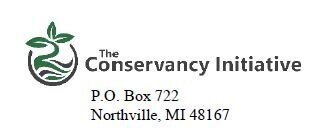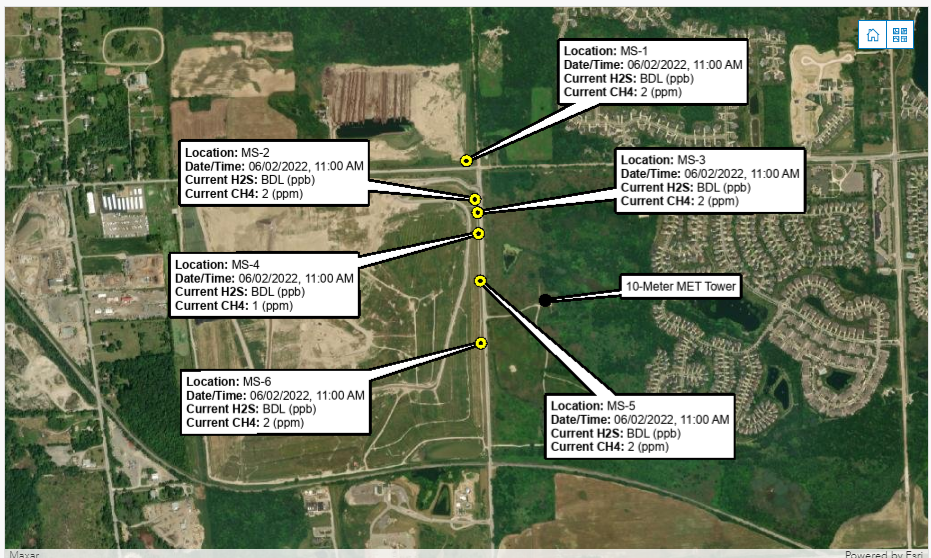One of the most significant pieces of the recent Consent Judgement (CJ) between the Arbor Hills Landfill and EGLE is the Perimeter Air Monitoring system agreed to by Arbor Hills. The air monitoring system includes six monitoring stations installed on the eastern border of the landfill and a weather station mounted 10 meters above grade just east of Napier Road. This system has been touted as one of the most advanced landfill air monitoring systems in the country. The system was designed to intercept and sample any landfill emissions before the prevailing winds direct the emissions toward Northville Township neighborhoods.
Fig 1 - Monitoring Station located on east side of landfill
Accurately monitoring landfill gas is difficult because there are hundreds or even thousands of different chemicals in the landfill gas depending on the materials which were disposed of at the landfill. The Arbor Hills Perimeter Monitoring system was designed to monitor for Hydrogen Sulfide (H2S) and Methane (CH4).
Hydrogen Sulfide (H2S) is produced during the decomposition of waste and has been measured at Arbor Hills during previous work. H2S can be toxic and is very odorous. The Perimeter Monitoring system can detect and measure H2S in concentrations as low as 7 parts per billion (ppb). The Consent Judgement requires Arbor Hills to take corrective actions if the H2S concentrations reach 122 ppb. Since the Perimeter Monitoring station was put in service approximately one month ago the system has not detected any H2S. Landfill gas is 40 – 50% methane. Methane (CH4) is generally not believed to be toxic or odorous but is easily measured. CH4 is monitored as an indicator that other more potential toxic or odorous constituents of the landfill gas may be present. If CH4 concentrations reach 40 parts per million (ppm) the Consent Judgement requires Arbor Hills to act.
Fig 2 - Screen shot from Perimeter Monitoring system webpage
Data from the Perimeter Air Monitoring Station is publicly available on a near real-time basis. We have provided a link to the Perimeter Air Monitoring Station data on the navigation menu of The Conservancy Initiative Website (https://conservancyinitiative.org/) or you can access the site directly at <CLICK HERE>. Hourly data are typically posted within two hours or the actual sample time. The Website contains the latest data shown on a satellite image of the site or historical data downloaded.
Residents are encouraged to continue submitting odor complaints if noxious odors are detected. Inquisitive residents may want to also review the data available from the Perimeter Monitoring system.
The Conservancy Initiative believes this monitoring system will be a valuable tool for diagnosing and troubleshooting excess emissions and odors being emitted from the landfill. We believe there will be a learning curve to determine how to make the best use of this data. Our early observations include:
H2S emissions have not yet been an issue
The background level for methane near the landfill is approximately 1.5 ppm (i.e. – 1.5 ppm methane always exists)
When daily average CH4 concentrations rise to 3 ppm odors complaints are more likely
CH4 concentrations tend to increase in the calm of the late evening and early AM hours (temperature inversion?)
The charts below use the average methane (CH4) concentration over a 20+ day period. They are not intended to infere a correlation to an instantaneous methane concentration. We do believe a correlatoin may exist between the odors, the instantaneous methane concentration, wind direction, and wind speed but more data and modelling will be required to develop the correlation.
Fig 3 - Average Methane Concentration compared to odor complaints
Fig 4 - Average Methane concentration as a function of time of day
We will continue to watch this data to learn as much as we can from it. We encourage anyone interested to do the same.





